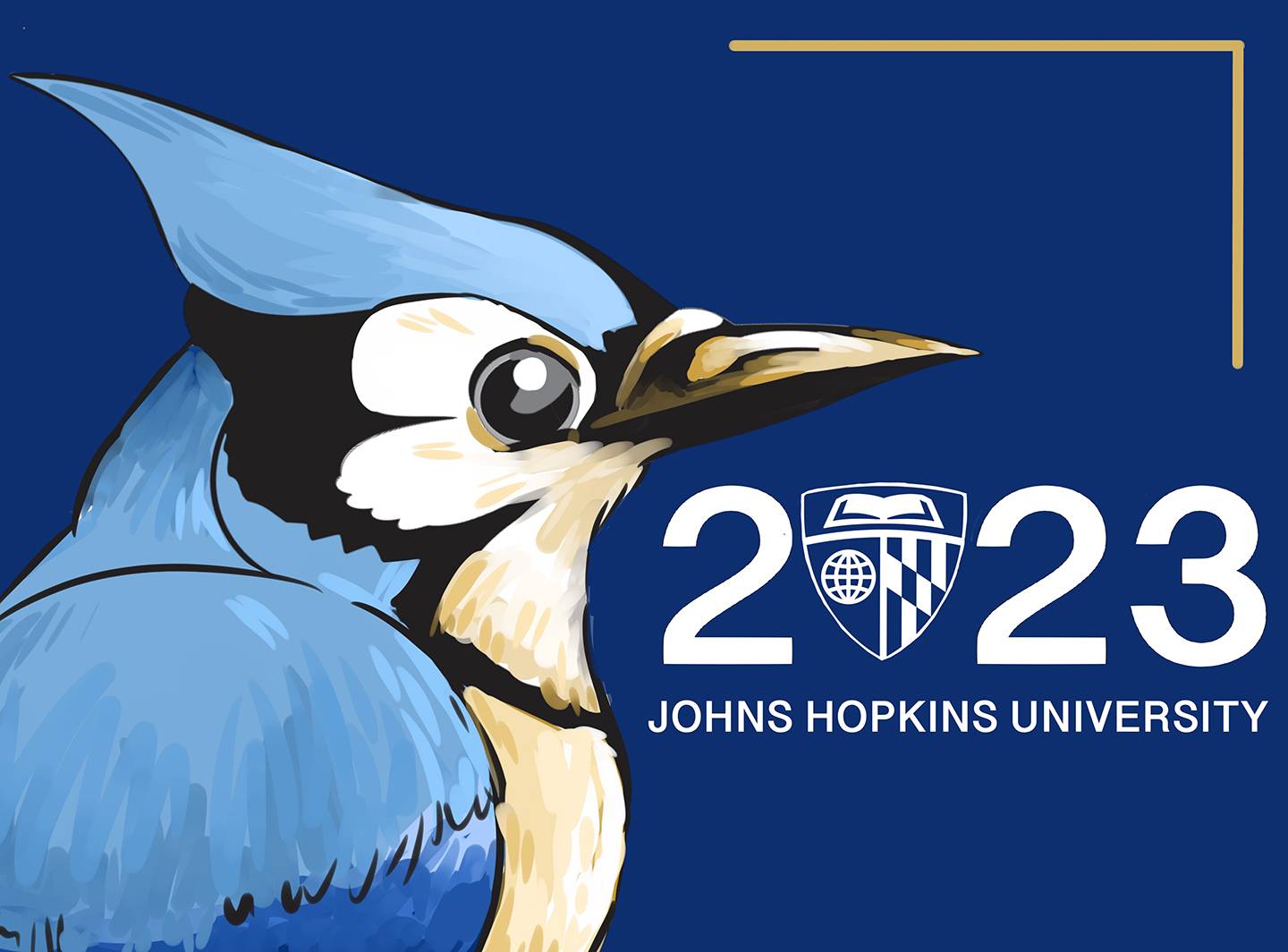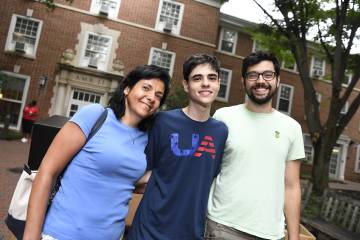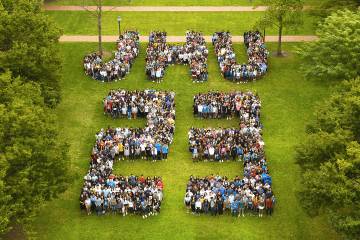Convocation is a moment to remember for new Johns Hopkins University students—the first formal event of their college careers and a chance to dress up and spend time with new friends.
But for Andrea Zhang, Convocation carried with it added meaning: During the event Wednesday evening in the O'Connor Rec Center, her winning design for the official Class of 2023 banner was unveiled. It will join other class banners in the Milton S. Eisenhower Library and remain a permanent symbol of the class.
"I'm still in disbelief," said Zhang, a first-year student from Basking Ridge, New Jersey. "I never expected anything like this to happen before the year even started."

Image caption: Class of 2023 banner, designed by Andrea Zhang.
Each year, incoming students are invited to submit designs for the class banner and vote for their favorite designs. Zhang had only recently gotten interested in digital art, she said, and she thought the competition would be a good opportunity to practice her growing skills.
The entire project took Zhang several days from concept to completion. She knew she wanted to incorporate the Hopkins Blue Jay but also utilize splashes of gold and black to reflect the school's academic colors. After exploring several font and layout ideas, she settled on the final design, sent it off, and hoped for the best.
Zhang is considering a host of extracurricular activities, including arts clubs, the debate team, intramural volleyball, business clubs, and more. She said she plans to study economics, but added that she is excited to pursue opportunities wherever they come from.
"In art, there's a freedom to just follow your heart and do what you're inspired to do," Zhang said. "And at Hopkins, there's a flexibility that I love and can't wait to explore, because I'm not sure what I want to do yet. I just know I want to do it here."
Before revealing Zhang's banner to the Class of 2023, JHU President Ronald J. Daniels welcomed the students to Johns Hopkins and shared the story of the Apollo 11 mission, which took astronauts to the moon 50 years ago. Daniels highlighted two different concepts NASA explored for the lunar module and described how a diversity of perspectives helped scientists refine their ideas and ultimately contributed to the mission's resounding success.
"We are a community that understands that ideas don't bloom in solitary and stifling darkness, but in the clarifying and dazzling sunlight of spirited debate and conversation," he said. "When we confine our thinking to narrow channels, we deaden our curiosity and undermine our chances to understand issues important to us all."
Presidents Daniels full remarks from 2019 Convocation
As prepared
Thank you, Vice Provost Phillips.
Thanks, Joshua and Aspen for your words and to Archipelago Project, the Sirens and the AllNighters for their great performances. And thanks to the entire Orientation team for doing such a phenomenal job! And to Trustee Stromberg for sharing his thoughts and for so much more that he does as a dedicated son of Hopkins.
Now, without any further ado, let me welcome the great Class of 2023, and all our extraordinary transfer students, to Johns Hopkins!
So, here you are. The final countdown to your first day of classes at Johns Hopkins has begun. It is a time of great excitement and perhaps a little trepidation. I can well remember my first days of undergraduate life and being in what I can only describe as a constant state of terrified exhilaration. Don't worry. It passes. In four years or so.
You might be wondering what your first assignments will be—the first big paper, the first exam, or perhaps most demanding, the first group project with a new cohort in which your fate rests in the hands of the collective.
Tonight, I want to put your minds at ease. Because, trust me, no matter how challenging, how intimidating, your first assignment will be—it could be worse. Much worse.
Consider the example of an assignment that was due 50 years ago this very summer.
In this case, the professor of the class was none other than President John F. Kennedy. The due date was much sooner than originally assigned, with no possibility of an extension. And completing it would require thousands of people from different backgrounds and different disciplines in different locations to work together.
Here was the mission:
[Video of the Apollo 11 countdown plays over President Kennedy's line from his speech to Congress: "I believe that this nation should commit itself to achieving the goal, before this decade is out, of landing a man on the moon and returning him safely to Earth."]
The assignment, of course, was the historic moon landing of July 20, 1969, one of humankind's most monumental feats.
We know in retrospect the team executed it with brilliance, verve, and majesty.
But when President Kennedy first issued the challenge eight years earlier, success was far from a foregone conclusion. The United States was trailing the Soviet Union, its chief rival in the space race, at every turn. The Soviets had launched the first artificial satellite into Earth's orbit and had put the first human in space.
President Kennedy understood that the United States couldn't win the space race by playing catch-up. He had to change the game. And so, he set an almost unfathomable goal on an audacious timeline. One that would require the can-do spirit, boundless imagination, and bold ambition that have fueled all our country's greatest achievements. And it would take a truly remarkable assembly of scientists and engineers to pull it off.
Like I said, not an easy group project.
So, after Kennedy's bracing announcement, NASA faced a tight timeline and a bewildering array of questions. How do we transport human beings 240,000 miles to the moon? How do we get them safely onto the lunar surface? Finally, how do we get them back—and all without the aid of Stark Industries' rocket-propelled space suits.
Two big ideas were under consideration.
The first was called "direct ascent." In this scenario, a single rocket blasts off from Earth and lands on the moon. Sounds straightforward, right? That's what a lot of eminent NASA scientists thought, too.
At first.
Except that a trip of 240,000 miles requires—excuse the pun—an astronomical amount of fuel and a rocket large enough to carry it. Imagine a cross between an Imperial Cruiser and the Empire State Building, complete with a 100-story elevator to take the astronauts down to the moon's surface.
The other idea was "orbital rendezvous." This plan would get the astronauts to the moon in stages. First, the shuttle would blast into orbit. Then, a module would detach from the main spacecraft to land on the surface of the moon. When it was time to return home, that module would reconnect with the main spacecraft and be carried back to Earth.
This approach had the advantage, among other things, of using smaller craft and requiring less fuel.
The downside was that astronauts would be required to detach and reattach parts of the spacecraft in space, all while traveling at many thousands of miles per hour. Imagine three-dimensional parallel parking at breakneck speeds.
Both ideas were enormously risky and devilishly complex. And NASA didn't have the money, people, or time to pursue both. One had to win the day, and the clock was ticking. So NASA tasked the most gifted engineers on the planet with determining which approach should prevail.
In meeting after meeting, paper after paper, and equation upon equation, the various camps made their pitches.
But, as you know from your own experiences, collaboration is seldom without stress.
As months sped by and pressures mounted, passions flared and people dug into their positions.
Some stopped listening to each other altogether—including the chief of Space Flight Programs, who was a die-hard advocate for direct ascent. At one gathering, he told his colleagues, and I quote, "I've been right most of my life about things, and if you guys are going to talk about rendezvous as a way of going to the moon, forget it."
Simple, succinct, and straight to the point—and, as the faculty behind me will attest, these kinds of statements are not the best of conversation starters among colleagues who value reasoned debate and argument.
Now, others at NASA were less dug in, and used the heated debate as an opportunity to deepen and refine their ideas.
One of those was John Houbolt, NASA's most tireless advocate for orbital rendezvous. Throughout the process, he faced withering criticism—even accusations of falsifying data—but he didn't flinch. He kept reworking his calculations and pressing the group to think more expansively. As he bluntly said at the time: "Do we want to go to the moon or not? And if so, why do we have to restrict our thinking to a certain narrow channel?"
Slowly, but surely, he began to win over the skeptics. When the time came for the heads of NASA to decide on the final approach in order to meet the president's deadline, the scientists argued their case one last time.
Rendezvous won the day.
[Images of the Apollo Lunar Module detaching from the spacecraft, moving toward moon's surface and landing.]
And the rest…
[Images of astronaut on the moon, and Earth seen from across the moon's surface.]
is history.
Now, I think I can safely predict—though not with complete confidence—that your first assignment at Hopkins will likely not involve interplanetary travel. (Though I can't make any assurances for your second.)
I can also assure you that like those at NASA—not only the space scientists, but the entire organization that made the moon landing happen—you are joining a community which believes deeply and passionately in the power of ideas to expand the horizons of knowledge and to advance the flourishing of our planet and of humankind. That is why you—indeed, why all of us—are here.
And we are a community that understands that ideas don't bloom in solitary and stifling darkness, but in the clarifying and dazzling sunlight of spirited debate and contestation.
Like NASA's intrepid engineer John Houbolt, we hope that you discover and develop ideas that you are willing to champion, bravely, in the public square.
We hope, too, that you will expose those ideas to perspectives radically different from your own so that in the end, your positions, your convictions are sharper, stronger, and more compelling.
Because when we confine our thinking to narrow channels, we deaden our curiosity and undermine our best chances to understand and address issues of importance to us all.
These are not mere platitudes. We have the data to prove it. Just check out a recent study in the journal Nature that showed that scientific papers with a greater diversity of authors have more impact. Differing perspectives, backgrounds, and experiences coalesce to produce more creative, relevant, and compelling ideas.
As philosopher John Stuart Mill trenchantly observed: "It is hardly possible to overrate the value of placing human beings in contact with persons dissimilar to themselves and … with modes of thought and action unlike those with which they are familiar." Such communication, he said, is the "primary source of progress."
And so, my call, my entreaty to you as you enter our academic community is this: Throw yourself entirely and without reservation into exploring big, urgent, complex questions.
Fight fiercely for your beliefs, but also listen intensively and respectfully to the fiercely held ideas of others.
Be architects of a "call-in" rather than a "call-out" culture. Ask the hard questions of your peers, your professors and, yes, even your university president.
Be open to answers that will guide and shape your thinking even as your perspective strengthens the thinking of others.
And know, above all, that you will not be going it alone, but in concert with others who share your aspirations and want to see them take soaring flight.
I have no doubt that you will bring forward ideas—as outlandish or perhaps even impossible as they may first seem—that will help us understand and improve our world and the worlds beyond.
To our newest Blue Jays, bon voyage!
Posted in Student Life
Tagged ronald j daniels, class of 2023, convocation










